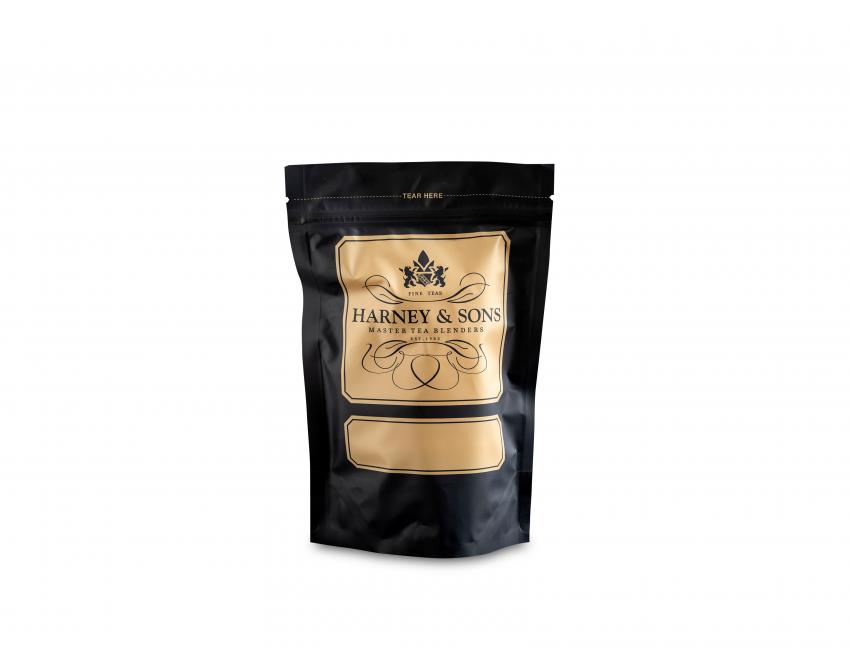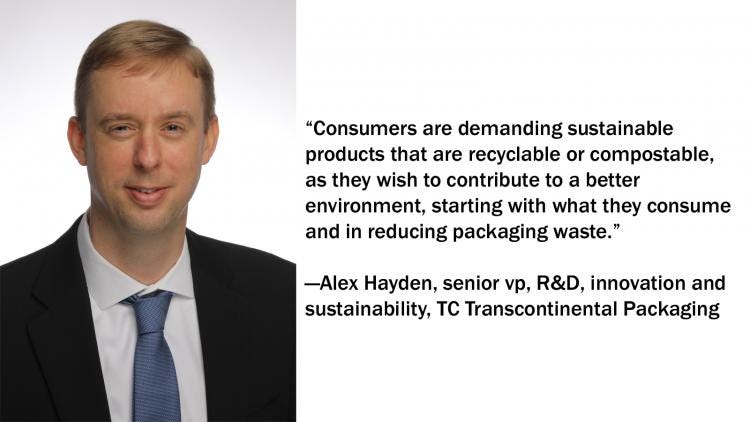A flexible packaging sustainability tale
October 2, 2019

TC Transcontinental Packaging helps brands rewrite their flexible packaging story using recyclable and compostable materials.
Packaging professionals and many more millions of people outside this dynamic market know well the importance of sustainability in all walks of life.
From the viewpoint of a packaging editor, this eco-minded approach is frequently front and center for numerous press releases and, usually negatively, in mass media reporting. Sustainable materials and containers are now a staple of trade shows, which is where I became more familiar on multiple occasions with the impressive array of sustainably-aligned flexible packaging from TC Transcontinental Packaging, the Packaging Sector of TC Transcontinental.
That interest reached a tipping point when the company was recognized for an award-winning package launched in North America earlier this year for one of the first-in-market, 100% recyclable, multilayer barrier stand-up pouches in partnership with American tea company Harney & Sons for their loose-tea flexible plastic pouch. The innovation was in the spotlight at the 2019 Flexible Packaging Achievement (FPA) Awards of the Flexible Packaging Association (FPA) where it won a Gold Award for Sustainability, a Gold Award for Packaging Excellence and the Silver Award for Technical Innovation.
I subsequently connected with the ideal contact at the company, Alex Hayden, senior vice president, R&D, innovation and sustainability, who enlightens us on the company’s commitment to sustainable flexible packaging.

First things first: How does the company define sustainable packaging?
Hayden: We define sustainable packaging as packaging presenting a lesser environmental footprint than that of alternative packaging solutions. It has been proven, through life cycle assessments (LCA), that flexible packaging uses less fossil fuels, offers an excellent product-packaging ratio, reduces greenhouse gas emissions and uses less water than other packaging formats. We also consider recyclable, compostable and reusable packaging formats and packaging made of post-consumer recycled content as sustainable.
We design our packaging for a wide range of end-product applications and seek to find the right balance between material composition and weight while ensuring an optimal product protection.
Being highly engaged in sustainable packaging development also means that we need to be part of the efforts made to tackle the challenge that flexible packaging presents, which is end-of-life management. Packaging composed of several polymers are currently more difficult to recycle. We are fully cognizant of this dilemma which is why our R&D Department dedicates substantial effort towards developing eco-responsible packaging solutions.
In terms of compostable films, we offer custom-designed solutions developed in collaboration with our customers. These solutions are made from 100% renewable resources. For example, we developed a new flexible peanut bag from certified compostable materials in order to support the green initiatives of arenas and stadiums in the United States that won a Gold award for Sustainability at the 2018 FPA Awards.
How would you characterize the current interest in sustainable packaging?
Hayden: When we first entered the packaging industry a few years ago, sustainable packaging was part of some of our discussions with customers, and usually came as a topic at the end of a meeting. Today, when meeting with our customers, independent of market or size, sustainable packaging solutions are top-of-mind and, more often than not, the very first topic of the meeting.
Brands are keenly aware of the growing global concern regarding the environment and have come to realize that consumers are looking for packaging options that are better for our planet. They are demanding sustainable products that are recyclable or compostable, as they wish to contribute to a better environment starting with what they consume and in reducing packaging waste. Consumers are also asking to understand how recycling works and how they can make a significant impact. There are definite opportunities to educate them on the topic.
In this context, many of our customers have already committed to sustainability targets of their own either through the New Plastics Economy Global Commitment or their Corporate Social Responsibility Plan. They are seeking to develop solutions with their partners and are more willing to test and commercialize those solutions faster. As such, we are definitely seeing a growing interest in sustainable packaging from our customers, as well as from all stakeholders involved in the supply chain, and beyond. We welcome the opportunity to collaborate with them and to continue supporting our customers along their own sustainability journey. Our R&D strategy is focused on a deep understanding of our customers’ needs and market trends. Working closely with our supply chain partners, we intend to accelerate the path towards a circular economy for plastic packaging.
Next: Challenges, options and best practices for brands
___________________________________________________________________________________
Packaging professionals can find pre-Halloween packaging treats in Minnesota during MinnPack 2019 (Oct. 23-24; Minneapolis) in the form of solutions for food packaging, package design, shipping and more. Attend free expert-led sessions at multiple theaters around the expo.
___________________________________________________________________________________

Les Aliments Jardi snacks are packed in 100% recyclable, multilayer barrier stand-up pouches that earned TC Transcontinental Packaging a 2019 PAC Canadian Leadership Award this summer.
What are the challenges in this market?
Hayden: The main challenge is that each market has its specificities, its set of applicable legislation and system regarding recycling infrastructures, etc. As such, there is an opportunity for harmonization in order to better support eco-design initiatives undertaken by manufacturers like us.
For example, the quality found in bales of outgoing materials from material recovery facilities is a challenge. If we want to create a market for these materials in order to have post-consumer plastic bought and reintroduced into the value chain, we need to ensure quality optimization from the get-go at sorting facilities. We are committed to acting together in a concerted manner with all stakeholders involved in order to rise to the packaging end-of-life challenges we are facing as an industry.
In order to support brands’ eco-design initiatives, it also must be fairly easy for consumers to recycle a package. Consumers need to know how and where to recycle. Recyclable film pouches are a good example: They can be recycled in almost any collection program that accepts plastic shopping bags. Most of the time, those collection systems are dedicated receptacles at retail stores.
What technological options drive this market?
Hayden: Technological options are acting as drivers in sustainable packaging. This is very much the case that came into play with our Harney & Sons pouch. For example, the importance of keeping a product fresh, especially when it’s a highly valuable item, such as tea, is key. In that case, a pouch with an ethylene vinyl alcohol (EVOH) barrier was necessary for our customer. We were able to achieve this in collaboration with our suppliers. Harney & Sons connected with us because they knew we could support their mission of giving back to the environment that grows the tea of the world.
We knew that a multilayer, coextruded film was essential to preserve the delicate flavor of tea by protecting the product’s natural oils that give tea leaves a smooth flavor and finish. We developed one of the first commercialized package for food that hits all notes: 100% recycle ready for in-store drop off, EVOH barrier for product preservation, seal strength, and durability. We know that EVOH delivers outstanding barrier to gases, organic vapors and moisture, preventing deterioration of the product and extending its shelf life; it plays a crucial role in food packaging.
However, the challenge with barrier films from a sustainability perspective is that it is not easily broken down and recycled, therefore hindering its reuse and contribution to positive environmental change. Dow’s Retain resin technology permitted the required barrier to be used and made multilayer film that was fully recyclable to achieve sustainability goals.
Our compostable peanut bag is another example of a collaboration that brought about science, technology and innovation and enabled us with our partners to create an industrially compostable film using certified compostable materials to support arenas and stadiums’ green initiatives and help sports teams, venues and leagues achieve the next level of landfill waste diversion.

What best practices can you share for brands desiring to move into packaging that’s more sustainable?
Hayden: We love to host ideation sessions with our customers and develop a true collaboration and partnership to drive innovation. These ideation sessions allow us to have open and candid conversations about the brand’s concerns and challenges. This interactive session is focused around the brand’s target consumer, new packaging ideas and product concepts. It allows us to find opportunities where sustainable packaging could resonate with the brand messaging as well as the consumers needs and expectations.
As best practice, we also recommend brands start small and implement quickly allowing us to assess the market and get consumers feedback. Meanwhile, it allows the brand to make that shift towards sustainable packaging, be agile and manage their image and perception in the market.
Finally, what’s a misconception about sustainable packaging that you can dispel?
Hayden: That not all plastic packaging is created equal! There are many misconceptions about flexible packaging. That is why we believe in educating and informing our customers, and in turn their consumers as well. Flexible packaging tends to be an exceptionally material-efficient, lightweight and with relatively low life-cycle impacts including carbon footprint, which is highly advantageous. It also offers sustainability benefits throughout its entire life cycle that should be communicated.
___________________________________________________________________________________
Packaging professionals can find pre-Halloween packaging treats in Minnesota during MinnPack 2019 (Oct. 23-24; Minneapolis) in the form of solutions for food packaging, package design, shipping and more. Attend free expert-led sessions at multiple theaters around the expo.
___________________________________________________________________________________
You May Also Like


